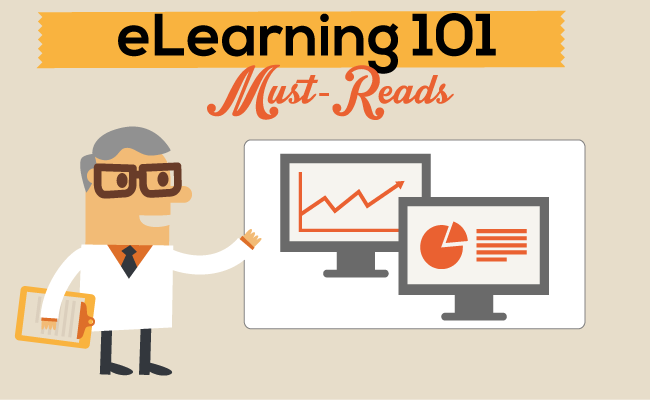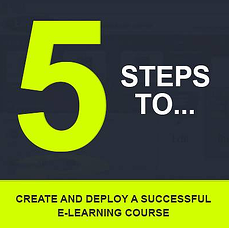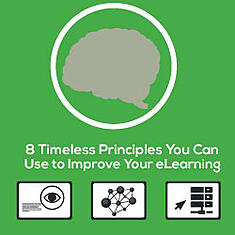New to eLearning course development? Never built a course before? You don’t have any formal background in designing educational materials and interfaces? Making something useful and effective can be a little bit daunting especially for first-timers. But don’t worry. Here are some indispensable reads to the basics of creating winning eLearning courses.
Read carefully through this list of suggested reads. You'll discover different techniques, tips and shortcuts to be a superior developer. Let this be your starters guide to building your very first eLearning course.

 1) Infographic: What is eLearning and what it isn't
1) Infographic: What is eLearning and what it isn't
There are plenty of myths and misconceptions around eLearning. Most people have some idea about what it is and use different definitions and apply it in different situations. People also reap different benefits from it.
For those planning to create a new eLearning course, the following points in this infographic will give clear direction to what is eLearning and what it isn't.
 2) Plan a successful eLearning program in 5 simple steps
2) Plan a successful eLearning program in 5 simple steps
Before you begin to develop your first course, it’s important to define the goals and purpose of the course. Considering what you really want to achieve is key. Are you looking to create a simple, user-friendly course or a more advanced course involving branching and scenarios?
Embarking on eLearning without understanding your end goal sets you up for failure. Use these 5 steps as a guide to develop and deploy an effective and engaging course that achieves your target objectives and benefits your learners.
 3) 8 Things Every eLearning Professional Should Know About People
3) 8 Things Every eLearning Professional Should Know About People
The art and science of design acknowledge the habits and actions of people. Effective images, video, and text take into account the reasons people do what they do to ensure the viewer gets the right information and takes and takes away the right message. Effective eLearning design also must incorporate this foundation of good design.
In this short and simple guide, you'll understand the eight habits of people that most apply to eLearning. Increasing awareness of why learners act in certain ways can increase the effectiveness of your eLearning courses.
 4) Understand how people learn
4) Understand how people learn
If you want to build successful eLearning, you have to learn more about how we learn. Armed with this understanding, you’re able to construct effective and efficient learning activities.
This article presents research about how we construct knowledge, develop skills, and build understandings for eLearning professionals to use in their course development. Use these timeless principles so you can create effective learning experiences for your students.
 5) Infographic: The ADDIE Model Explained
5) Infographic: The ADDIE Model Explained
To make the content development process efficient and smooth, instructional designers and content creators don’t need an array of complex models– they just need ADDIE.
ADDIE (Analysis, Design, Development, Implementation & Evaluation) is the framework used by most people for training development. It helps people think about the different steps in a course.
For those of you who are new to the field, this infographic provides a clear overview. There is certainly more to each phase of the process, but this is a good place to start.
 6) 3 Writing Styles That Make a Positive Difference in Web Users’ Performance
6) 3 Writing Styles That Make a Positive Difference in Web Users’ Performance
Studies of how users read on the Web suggest that current web writing often does not support users in achieving their main goal: finding information as quickly as possible.
For eLearning to be effective, text has to be written well, and written well for an online audience or no one will read it. Corporate speak writing won’t be read naturally. Long texts without images will be skipped. Writing that isn’t straightforward, conversational, and relative to the learner will be ignored.
Check out Nielsen Norman Group Study: How to Write for the Web and start making use of all three principles in your courses.
 7) Animated cartoon: 6 steps to save the world from boring training
7) Animated cartoon: 6 steps to save the world from boring training
Boring eLearning is a huge problem for learners and instructors alike. Most of the students, quite understandably, avoid them like plague. Everyone in the teaching and training profession knows this. The problem is, why are people still creating boring courses?
Cathy Moore created this funny video to help people understand how humor can improve learning. She mentions several studies that suggest (relevant!) humor in teaching can increase retention, motivation, and comprehension.
 8) Levels of interactivity in eLearning: Which one do you need?
8) Levels of interactivity in eLearning: Which one do you need?
If you are creating your first eLearning course right now, planning to develop or are just interested in this type of training, you should know that eLearning courses can be classified according to the level of interactivity offered.
According to these levels of interactivity, you can determine how interactive you want your eLearning courses to be.
 9) Quick Insights: Create storyboards like the experts
9) Quick Insights: Create storyboards like the experts
Many people who are new to eLearning want to know how to create a storyboard. Storyboards are a helpful tool mainly because they describe every screen in a course including what the learners will see, do and hear.
Industry expert, Connie Malamed gives her tips and insights on this topic. She suggests things you should consider to develop effective storyboards.
Additionally, she offers a free storyboard template you can download (if you are just starting, this is a must-have).
 10) Teach Yourself Visual Design
10) Teach Yourself Visual Design
Designing websites, interfaces or eLearning courses are not the easiest of tasks. It takes some careful planning and thought.
Many times, eLearning professionals responsible for creating courseware don't put enough attention on visual design. And guess what? First impressions definitely matter in eLearning. It takes only 1/10th of a second to form a first impression about a person, and in eLearning this works equally.
Review the basics of visual design for putting together a visually pleasing eLearning course in no time.







